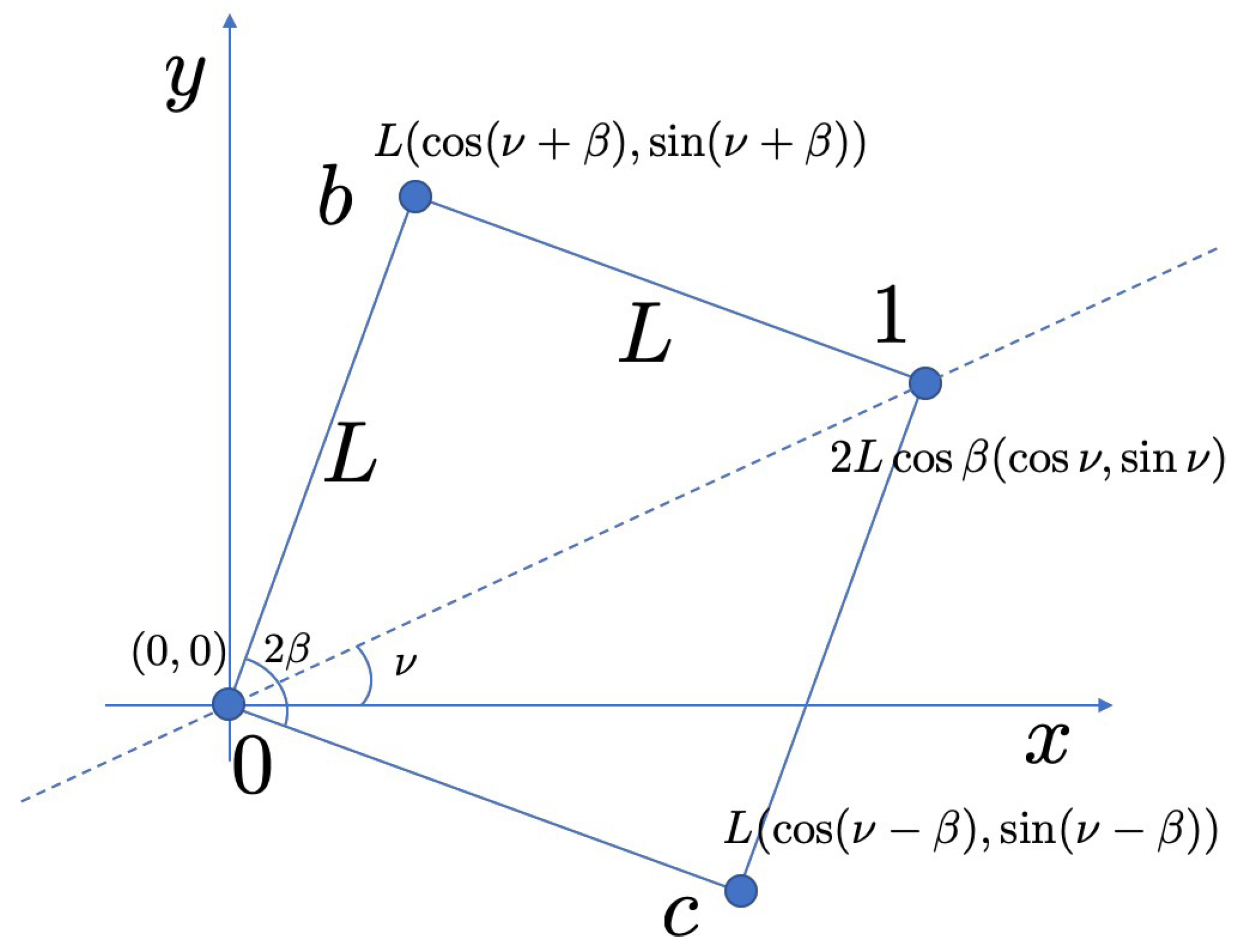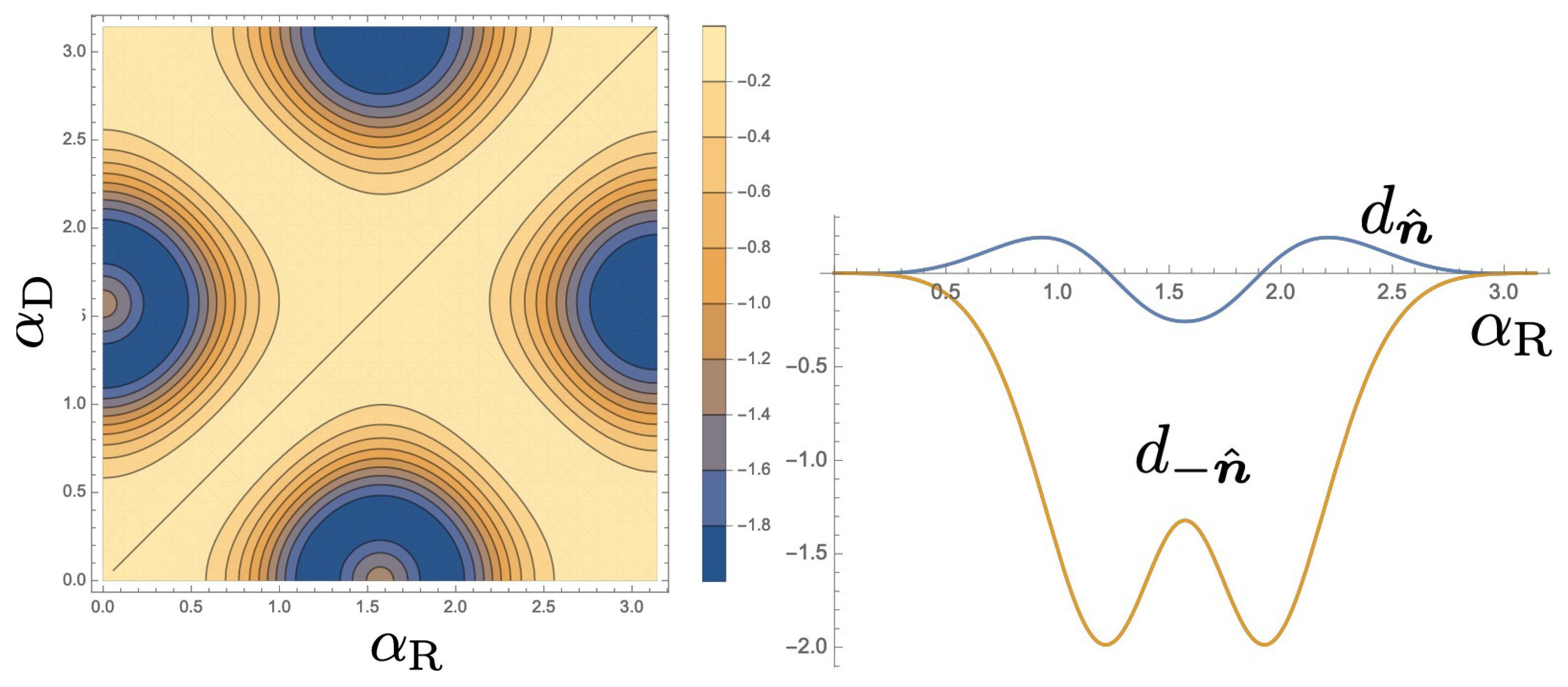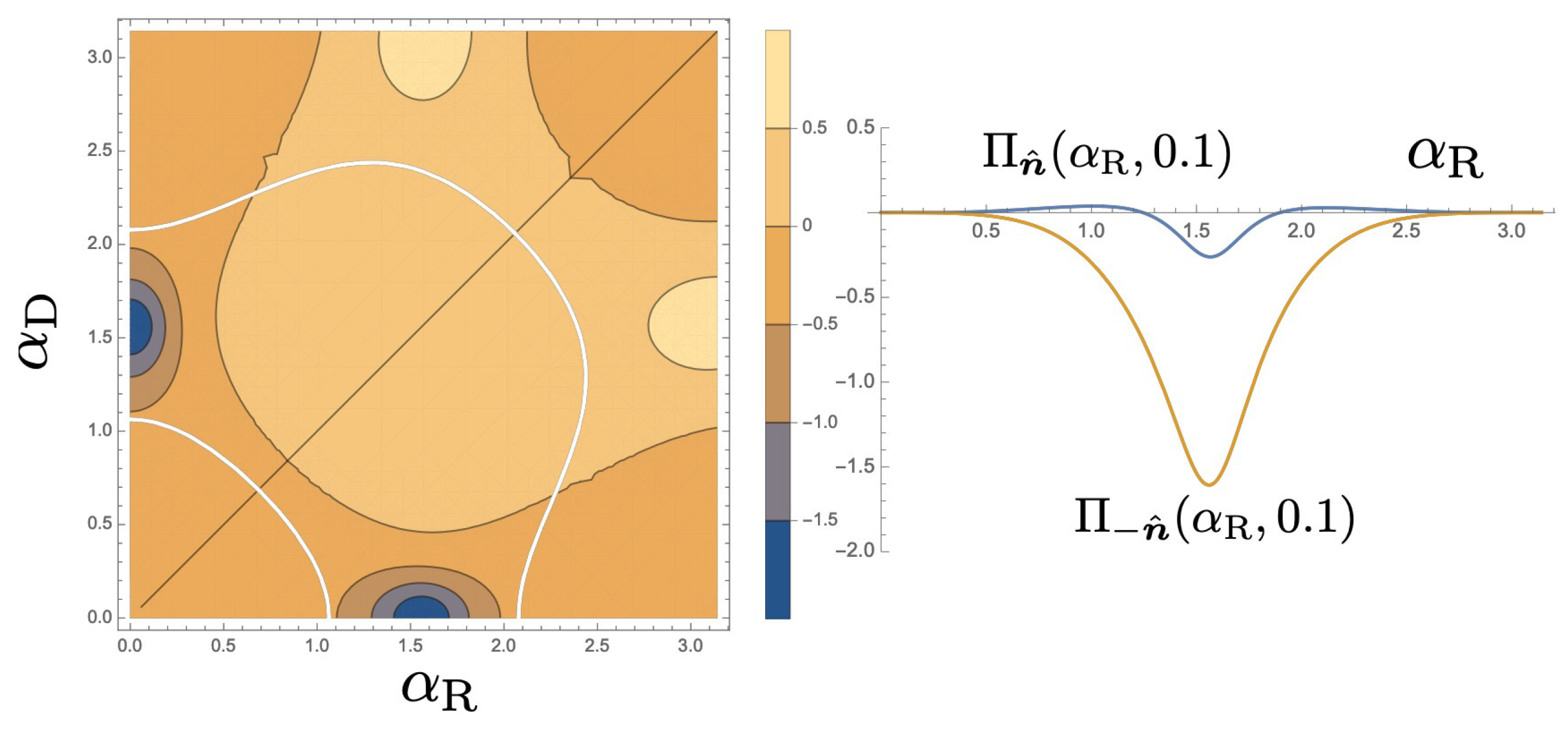1. Introduction
Coherent transport in mesoscopic systems is of fundamental interest since it allows realization of various phenomena observed in quantum optics in a solid-state system. Furthermore, the electron spin degree of freedom adds an intriguing knob for the manipulation and observation of the transport phenomena. Spin-orbit interaction (SOI) effect [
1] is one of the key ingredients in narrow-gap semiconductor devices, whose strength can be controlled by external gates [
2], in principle, without changing the electron density. Introducing the effect of SOI to the electron interferometer structure is quite attractive since it enables perfect spin filtering effect [
3,
4,
5]. Moreover, transient behavior in such an interferometer has been investigated [
6].
In addition to passive functional devices such as filters, the active functions, for example, spin-pumping or spin manipulation effect by dynamically modulating the gate voltages [
7,
8,
9], magnetic field [
10,
11,
12,
13], or magnetization of the ferromagnets [
14,
15,
16,
17], has been investigated. In particular, quantum adiabatic pumping (QAP) phenomena [
18,
19], which stems from geometrical properties of the dynamics, is an active field of research [
20,
21,
22,
23,
24,
25]. In the non-interacting limit, QAP is related to the scattering matrix of the coherent transport. We have investigated the QAP effect by adiabatically modulating the Aharonov-Bohm (AB) phase [
26] of the interferometer as well as the local potential in the interferometer. However, it seems no studies have been made of the adiabatic spin-pumping with purely geometric means such as Aharonov-Casher phase or AB phase. The fundamental question here is whether QAP is possible by only modulating the electron geometric phase.
In this work, we studied spin-QAP in Rashba-Dresselhaus-Aharonov-Bohm interferometer introduced in [
3] using Brouwer’s formula [
19] and derived an explicit formula of the Berry curvature for each spin component. Using the obtained result, we clarified the condition of finite spin-pumping. In
Section 2, we introduce a simple two-terminal setup and the expressions of the scattering amplitudes.
Section 3 explains the details of the eigenstates of the scattering problem. Then, with these states, the formula of the QAP is derived in
Section 4. It is shown that the modulation of the AB phase cannot induce QAP.
Section 5 explains the properties of the diamond-shape interferometer, and is applied to study QAP assuming Rashba SOI and Dresselhaus SOI strengths as control parameters in
Section 6. Finally, discussions follow in
Section 7 and Appendices are included for the detailed derivations of the formula used in the main text.
We consider a standard setup of scattering problem of spin
electrons as shown in
Figure 1. A coherent scattering region (interferometer) is attached at the site
with the one-dimensional left lead made of sites
and is attached at the site
with the one-dimensional right lead made of sites
. The assumption of one-dimensional leads is not essential as far as the interferometer is coupled to the leads via single mode scattering channels. However, the one-dimensional tight-binding formalism benefits from its simplicity. Although the analysis is standard, the obtained rigorous scattering amplitudes and corresponding scattering eigenstates are essential to clarify the condition and to quantify the quantum adiabatic spin-pumping, as will be shown in the later sections. We introduce the spinor ket vector at site
u,
where the two amplitudes
for spin
satisfy normalization condition
. The total Hamiltonian in the tight-binding approximation is given in general
where the site index
u and
v run the entire system. The real parameter
is spin-degenerate site energy and
is a
hopping matrix satisfying
. We assume that the hopping matrix
is only non-diagonal in the scattering region between
and
. We neglect the electron-electron interaction.
2. Model System
In the leads , , we set and , where is the two-dimensional unit matrix and the real hopping parameter j is only nonzero for nearest-neighbor pair of . With a standard treatment on the tight-binding Hamiltonian, we obtain the eigen-energy and its corresponding eigen-function, , where k is a real wave-number parameter, is the lattice constant and is a certain state vector.
The system of interferometer is represented between
and
sites and we choose
and
and
and
. The microscopic derivations of
and
for a diamond-shaped interferometer are demonstrated in
Section 5. Then the Schrödinger equations at sites
read
The reflection and transmission amplitude matrices for the electron flux with an energy
injected from the left lead is
where
with complex parameters
(
) and we introduced a parameter of energy dimension
. The reflection and transmission amplitude matrices for the electron flux injected from the right lead is
The details of the derivation of these formulae are given in
Appendix A. In the next section, the obtained scattering amplitude matrices are diagonalized and the formulae of the scattering amplitude eigenvalues are given. Then in
Section 4, the Berry curvatures for two spin eigenstates, Equations (
34) and (
35), is given, which allow calculation of QAP spin per cycle.
3. Diagonalization of Hopping Operator
In this section, we diagonalize the product of hopping operators
and
appearing in the scattering amplitude matrices derived in the previous section. Then we obtain the scattering eigenstates through an interferometer. This is an extension of the discussion in Reference [
3]. We consider an interferometer in
plane made of two one-dimensional arms,
b and
c, represented by real coupling parameters
and
unitary matrices,
and
, showing propagation from the site 0 to 1 via the arms
b and
c, respectively. We assume following general expressions characterizing the effect of AB phase and Rashba or Dresselhaus SOI:
where
is the vector of Pauli spin matrices.
is the AB phase with the magnetic field
H in the
z direction, the area of the interferometer
S, and a magnetic flux quantum
. Unitarity condition requires the real parameters,
and real three-dimensional vectors
to obey
. The hopping matrix
is given by
As shown in
Appendix B, the matrix factor appearing in the scattering amplitudes for the electron flux injected from the left lead, Equation (
5), is
where
The real parameter
is determined from
and the unit vector
is defined by
We then introduce two normalized eigenstates of the operator
,
and
such that
Clearly, these are also the eigenstates of the operator
such that
with the eigenvalues
These eigenvalues are positive since
To study the scattering eigenstates for the electron flux injected from the right, Equation (
7), we evaluate
with similar procedure as above,
where
and corresponding unit vector
Then we introduce two normalized eigenstates of the operator
,
, which obey
with the same eigenvalues as Equation (
18).
The elements of the scattering matrix are now explicitly evaluated with the obtained scattering eigenstates. As detailed in
Appendix B, we can show that the transmission amplitude matrices are
where we defined two transmission amplitudes,
Similarly, the reflection amplitude matrices are given by
where the reflection amplitudes are
The unitarity condition of the scattering amplitude matrices,
, is confirmed in
Appendix C. The unitarity condition
can also be checked.
4. Quantum Adiabatic Pump
For a non-interacting system, the response (particle transfer) to the slow modulation of the system’s controlling parameters is well described by Brouwer’s formula [
19], which is expressed by the elements of the scattering matrix. The particles induced in the left lead in one cycle of the adiabatic modulation of two control parameters
and
is
where
S is the area in the two-dimensional control parameter space whose edge corresponds to the trajectory of the cycle. The Berry curvature
for spin
is
where
and
are given in Equations (
27) and (25) and
is the spinor vector of spin
.
If we choose the AB phase
and parameters of the interferometers, for example,
or
, but not the SOI strengths, we can show that the Berry curvature is finite in general as studied in Reference [
26]. In the following, however, we focus on the situation that the control parameters are the AB phase
and Rashba or Dresselhaus SOI strength that modulate the eigenvalue
as well as the scattering eigenstates
. To calculate the Berry curvature, we need to evaluate the derivatives of the scattering amplitude matrices,
and
. Then, as shown in
Appendix D, after some manipulations, we have the Berry curvatures for spin components parallel to
,
and
where the factor at the end is independent of spin and is defined as
This is one of the main results of this work.
The vector
is independent of
, but only depends on the SOI strength. Therefore, when one chose the AB phase,
, as one of the control parameters,
is identically zero as is evident from Equation (
36). Hence we do not expect QAP by modulating the AB phase and SOI strength. It is also obvious that if we chose
or
as one of the control parameters and the other by SOI strength,
is zero since
is independent of
and
and no pumping is expected.
Even for a fixed AB phase, there is still some freedom to choose two control parameters related to the SOI strength since we have two types of SOI interaction mechanisms, Rashba and Dresselhaus SOI. In the next section, we study Rashba-Dresselhaus interferometer in a simple diamond-shape structure made of four sites and choose the strengths of two types of SOI as control parameters.
5. Diamond Interferometer
We consider an electron transport in two-dimensional system on
surface with setting
x and
y axis along the
and
crystal directions, respectively. The Hamiltonian for the SOI is
where
and
are Rashba and Dresselhaus parameters, respectively.
(
) are the momentum and
m is the electron effective mass.
The interferometer made of four sites is configured as in
Figure 2 which is attached to the leads at site
and
as discussed in Reference [
3]. Other two sites constituting the interferometer are
and
, connected with bonds of length
L. We also define the opening angle
and the relative angle
of the diagonal line to
x axis. The Hamiltonian reads
for
where
is the site energy and
,
is a hopping energy and
is a
unitary matrix representing the effect of SOI and AB phase. Total Hamiltonian is
. In the
Appendix E, we explain how this problem is reduced to the Schrödinger equations, Equations (
3) and (4).
The coordinates of the four sites are
,
,
, and
. We define
,
and
and introduce another angle
, such that
, and
. The unitary matrix for the hopping from site at
to site at
is
with
[
27]. Therefore, for the hopping from site 0 to
b,
with
and
. Similarly, for the hopping from site
c to 0,
with
and
. We introduce factors
and
such that
and
. Then, for
,
where we defined
Noting that
,
,
and
,
where
Similarly,
with
and
. The angle
is determined by
.
7. Discussion
We have derived a general expression of the Berry curvature for an interferometer connected to one-dimensional leads. In this study, we restricted the control parameters in QAP formalism only to modulate the scattering eigenstates and corresponding eigenvalues through the change of the unitary operators for each arm. Then the AB phase, which, despite modifying the scattering eigenvalues,
, does not affect the scattering eigenstates and is shown not to function as a control parameter in QAP. In a clear contrast, it has been shown [
26] that in combination with the potential modulation, affecting the electron-hopping amplitudes or site energies, QAP by AB phase is possible.
In the current analysis, the control parameters are assumed to purely modulate the phase of the electrons. In real experiments, unintended modulation of hopping amplitudes,
, or the site energies,
or
by the gate voltages may induce additional effects. We demonstrated that by using the two types of the SOI as the two control parameters, spin-QAP is possible. However, in the experiments, independent control of the Rashba SOI and Dresselhaus SOI will be a complicated task. Fortunately, as shown in
Figure 6, the area of large Berry curvature is well isolated and the tiny change of Dresselhaus SOI may be sufficient to observe QAP. It would be interesting if other types of SOI interaction [
5] could be another control parameter of the QAP.










